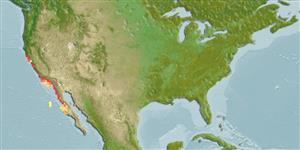>
Blenniiformes (Blennies) >
Chaenopsidae (Pike-, tube- and flagblennies)
Etymology: Neoclinus: Greek,neos = new + Greek, klinein, kline = sloping and bed, due to the four apophyses of sphenoid bone (Ref. 45335); uninotatus: Neoclinus new Clinus ; uninotatus one mark, for the single ocellatus (Ref. 4930).
Environment: milieu / climate zone / depth range / distribution range
Ecologia
marinhas demersal; intervalo de profundidade 3 - 27 m (Ref. 2850). Subtropical; 39°N - 27°N, 124°W - 114°W
Eastern Pacific: Bodega Bay in northern California, USA to northern Baja California, Mexico.
Comprimento de primeira maturação / Tamanho / Peso / Idade
Maturity: Lm 8.9 range ? - ? cm
Max length : 25.0 cm TL macho/indeterminado; (Ref. 2850); idade máx. registrada: 7 anos (Ref. 43439)
Usually occurs on bottom along coast and in bays. Lives inside objects, including bottles, cans, and tires.
Females lay eggs in abandoned boring clam holes, under rocks, in beer containers, and other containers. Males guard the eggs until they hatch (Ref. 43439).
Eschmeyer, W.N., E.S. Herald and H. Hammann, 1983. A field guide to Pacific coast fishes of North America. Boston (MA, USA): Houghton Mifflin Company. xii+336 p. (Ref. 2850)
Status na Lista Vermelha da UICN (Ref. 130435: Version 2024-1)
Ameaça para os humanos
Harmless
Uso pelos humanos
Ferramentas
Relatórios especiais
Baixar XML
Fontes da internet
Estimates based on models
Preferred temperature (Ref.
123201): 12.8 - 19, mean 15.9 °C (based on 43 cells).
Índice de diversidade filogenética (Ref.
82804): PD
50 = 0.5005 [Uniqueness, from 0.5 = low to 2.0 = high].
Bayesian length-weight: a=0.00525 (0.00219 - 0.01260), b=3.06 (2.85 - 3.27), in cm total length, based on LWR estimates for this (Sub)family-body shape (Ref.
93245).
Nível Trófico (Ref.
69278): 3.5 ±0.50 se; based on food items.
Resiliência (Ref.
120179): médio(a), tempo mínimo de duplicação da população 1,4 - 4,4 anos (tm=1; tmax=7; Fec = 600).
Fishing Vulnerability (Ref.
59153): Low vulnerability (15 of 100).
